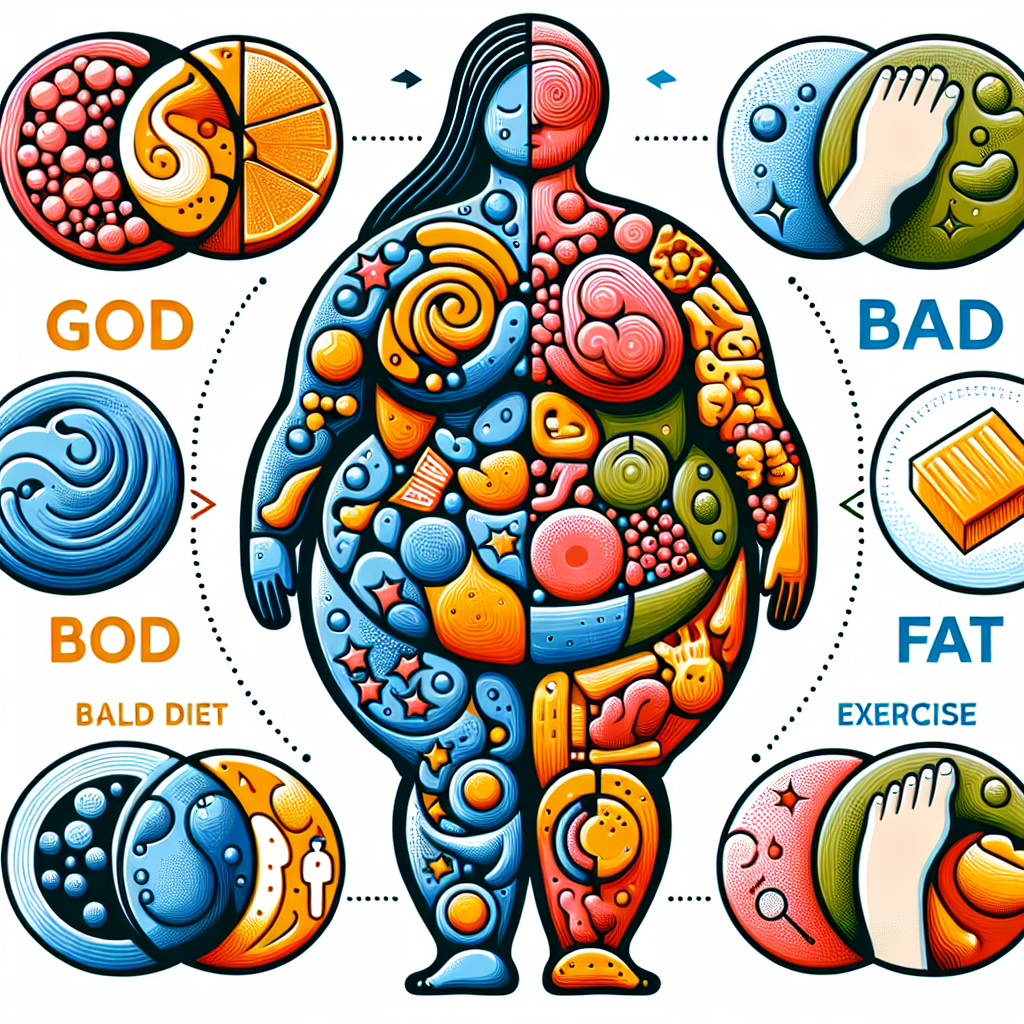Misconceptions about Body Fat: Lessons from Sophie
“Misconceptions about Body Fat: Lessons from Sophie” provides a comprehensive overview of common misconceptions and lesser-known facts about body fat. Drawing on Sophie’s experience, the article explores diverse content shedding light on a plethora of topics including the difference between essential body fat and storage body fat, the appearance of various amounts of fat–from one pound up to 100 pounds–and the healthy body fat range. It also delves into fat as a nutrient, touching on fat-soluble vitamins and the role of fat in the human body. Challenging preconceived notions and stereotypes, the discussion extends beyond aesthetics and weight concerns to examine societal attitudes, including unrealistic beauty ideals and discrimination against fat individuals.
Understanding Body Fat
Defining total body fat
Total body fat refers to the overall amount of fat in the human body. It encompasses all fat deposits within the body including visible and non-visible fat. This accumulation of fat plays essential roles in body functioning and is a significant aspect of overall health.
Important functions of fat in the human body
Contrary to popular belief, body fat plays crucial roles in maintaining overall health. It provides the body with a source of stored energy, acts as insulation, protecting bones and internal organs from trauma and temperature changes, and is involved in the production and regulation of hormones. It is also essential for the absorption of fat-soluble vitamins, improving cognitive functioning, and supporting cell growth.
Distinguishing between essential and storage body fat
Body fat can be classified into essential body fat and storage body fat. Essential body fat is the minimum amount of fat necessary for basic physiological functioning. This includes fat stored in the heart, lungs, liver, and other organs. On the other hand, storage body fat consists of fat accumulation that protects the internal organs in the chest and abdomen.
Misconceptions about Body Fat
Association of fat with unhealthiness
Many people associate body fat with unhealthiness or overweight. But it is essential to understand that some amount of fat is necessary for survival. It becomes a problem when the percentage of body fat is too high, leading to overweight and obesity, which are associated with health complications.
Belief that all fats are the same
Another misconception about body fat is the belief that all fats are the same. There are, in fact, different types of fat that the body uses and produces. These include unsaturated fats, saturated fats, and trans fats, each having different effects on the body.
Assumption that low body fat is always beneficial
The assumption that low body fat is always beneficial is another misconception. Although high body fat is associated with heart disease and other health conditions, too little body fat can also cause health problems such as hormonal imbalance and impaired immune function.

The Real Image of Fat
Visualising 1 lb, 5 lbs, and 15 lbs of fat
visualizing fat is essential for understanding its amount and impact on the body. One pound of body fat is about the size of a small grapefruit. Five pounds of fat is approximately the size of a small loaf of bread, whereas 15 pounds is similar to a medium-sized watermelon.
Understanding what 20, 30 and 100 pounds of fat look like
Understanding the visual scale of body fat further, 20 pounds of fat can equate to a car tire, 30 pounds to a large dog and an astounding 100 pounds of fat is similar to having a whole person strapped around one’s waist.
Implications of Too Little Or Excessive Body Fat
Health consequences of too little body fat
Having too little body fat can lead to serious health issues. These may include difficulties in controlling body temperature, increased risk of infections, hormonal imbalances, and even issues with fertility. Moreover, low body fat could potentially have a poor impact on the absorption of vitamins, thus leading to deficiencies.
Why excess body fat can be harmful
excess body fat correlates with a number of health risks including obesity, heart diseases, stroke, diabetes and certain types of cancer. It can also lead to metabolic syndrome, sleep apnea, and a plethora of liver and kidney diseases.

Sophie’s Body Fat Percentage: A Healthy Example
Sophie’s total body fat percentage
The healthy body fat percentage varies depending on factors like gender and age. For instance, Sophie’s total body fat is 30%, which places her in the healthy body fat range.
Why Sophie is in the healthy body fat range
Sophie’s body fat percentage is considered healthy because it falls within the recommended range for her gender and age. It is adequate to support her basic physiological needs and provide energy for daily activities, without predisposing her to health risks associated with too little or excessive body fat.
The Connection Between Fat and Diet
Healthiest fats for cooking
All fats are not created equal when it comes to cooking. The healthiest fats for cooking include monounsaturated fats and polyunsaturated fats. These are considered heart-healthy fats and include options like olive oil, avocado oil, and canola oil.
Impact of fat-soluble vitamins
Vitamins A, D, E, and K are fat-soluble vitamins, meaning they require fat in the diet to be absorbed by the body. Without adequate body fat, the absorption of these vitamins can be compromised, potentially leading to nutrient deficiencies.
The role of protein, carbohydrate and fat
In our diet, protein, carbohydrate, and fat all play crucial roles. Protein is important for building and repairing tissues. Carbohydrates provide the body’s primary source of energy. Fat, though high in calories, is needed for many body processes, including nutrient absorption.
The Role of Exercise in Body Fat Management
How exercises like squats can help lose belly fat
For losing fat, particularly around the mid-section, exercises like squats can prove to be beneficial. Squats work your core and entire lower body, which helps burn calories, eventually leading to loss of body fat.
Influence of physical activities on body fat distribution
Physical activity affects not only the amount of body fat you carry but also where you carry it. Certain physical activities reduce visceral fat – a type of fat found around the organs. Guided aerobic exercises and resistance training can be beneficial to manage body fat distribution.
Body Fat and Exercise: Real-life Stories
Lessons from ‘fit to fat to fit’ reality show
A striking example of body fat management can be taken from the reality show ‘Fit to Fat to Fit‘. This series revolved around trainers who gained weight in order to understand the struggles of their clients, demonstrating the role of diet and exercise in managing body fat.
Why powerlifters often seem fat
Powerlifters may often seem fat due to their larger body size. Although they may carry a higher amount of fat, they also have a considerable amount of muscle mass that contributes to their overall size. It is important to understand that appearance doesn’t directly correlate with health.
Public Perception and Body Shaming
The story of ‘I miss my boyfriend when he was fat’
The story ‘I miss my boyfriend when he was fat’ provides insight into the prejudices surrounding body fat. Within this context, even personal relationships can be affected by how society views body fat and the biases held about individuals who fail to fit into ‘defined’ body norms.
The problem with making fun of body fat
Making fun of someone’s body fat can result in severe emotional and psychological damage, potentially leading to low self-esteem, anxiety disorders, depression, and even eating disorders. Such body shaming should be avoided to cultivate a respectful and supportive environment.
How to Foster a Healthy Relationship with Body Fat
The importance of embracing and respecting body fat
Embracing and respecting body fat is crucial to fostering a healthy relationship with our body. Body fat is a natural part of our body composition and serves vital roles in our overall health. We must remember this when thinking about our own or others’ body fat.
Strategies for maintaining a healthy body fat percentage
Maintaining a healthy body fat percentage involves a balanced diet that includes all the essential nutrients, regular physical activity, and adequate sleep. Regular monitoring of body fat levels and making necessary adjustments in lifestyle habits are key to effective body fat management.


Pingback: Demystifying Vitamins: Which isn’t Fat-Soluble? - Lose Weight With Absolute Minimal Diet - Your All In One Guide to Weight Loss & Nutrition
Pingback: Understanding the One Non Fat-Soluble Vitamin - Lose Weight With Absolute Minimal Diet - Your All In One Guide to Weight Loss & Nutrition
Pingback: Decoding Sophie’s Healthy Body Fat Percentage - Lose Weight With Absolute Minimal Diet - Your All In One Guide to Weight Loss & Nutrition